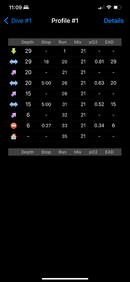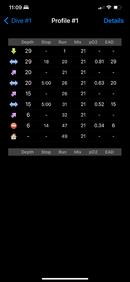Monday's boat dive has me rethinking guided dives. My computer is set for gf85. I usually dive unguided, and solo, I keep a close watch on time, depth, gas remaining, and NDL. So, on Monday we were guided on a recreational dive moderately deep. initial descent was to 65 ft, then proceeded down the slope maxing out at 115 for about 5 minutes, then continuing around. everyone seemed to be blissfully happy following the guide, but my low NDL numbers were blinking. I let them get down to 1, and decided I really needed to take care of me. As no buddys were agreed to before the dive (6 divers, a couple, a father/son pair, and two loners). As the other loner had already signaled 1000psi, I joined him above the group. Vis was great, and I had a better appreciation of the site from 25 feet up. As the main group started their ascent, we two loners went to safety stop depth, and I let my 5 min (adaptive) timer expire, then signaled going to the boat.
After the dive, I asked our guide if maybe my computer was misleading me, the guide casually said no, she was several minutes into DECO, but just did a "slow ascent". Comparing with two other experienced divers, they were into DECO. The two loners may have been the only ones within NDL, him because of low air, and I had been watching my limits.
This is not a normal occurrence, but I have seen it in maybe 5-10% of guided dives - most all on the first dive of the day.





